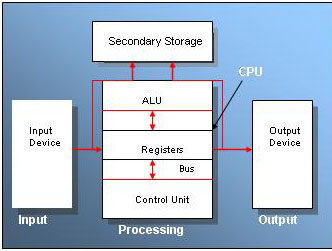CCNC/CCNC Module 1/Hardware/Subsection Level CCNC Template3
Parts of the CPU
At the core of every computer is a device known as the central processing unit, or CPU in short. The CPU is the brain of the computer generally referred to as processor or central processor. CPU reads and executes program instructions, performs calculations, and makes decisions. It controls the operations of all the hardware of the system and is responsible for storing and retrieving information on disks and other media. There are three main components to the CPU: the arithmetic-logic unit (ALU), control unit and primary memory.
Arithmetic-logic unit: The actual data processing takes place in the Arithmetic and Logic Unit (ALU) of a computer. The ALU is responsible for carrying out arithmetic operations like (+, -,*,^, /), logical operations like (AND, OR, NOT) and relational operations like (<,>, <=, >=). All programs consist of complex sets of arithmetic and logical operations. All mathematical operations are performed in binary numbers and all logic operations through binary operations.
Control unit: The control unit is responsible for loading and interpreting the individual instructions that constitute the computer program. These instructions are in a language called machine code represented in a pattern of ones and zeros. The control unit also has the task of fetching the data needed by the instructions and returning the results after the instruction has been executed. Control unit controls and coordinates all hardware operations. The ALU responds to commands from the control unit. The primary functions of Control Unit are to:
- Read and interpret machine language instructions
- Control transmission of data between ALU, registers, caches, primary memory and auxiliary memory
- Control sequence of execution of program instructions
- Direct ALU to mathematical or logic operations
Primary memory: primary memory provides temporary storage of programs in execution and the data being processed. It is an immediate access storage device. Primary memory can be further classified in to Random Access Memory (RAM), Read only memory (ROM) Because the CPU can perform its operations much faster than data can be transferred from RAM, many CPUs have on-board cache memory. This is memory that the control unit can access very quickly and use for intermediate storage. Further, data and instructions can be loaded into cache before they are actually needed. When they are needed, the transfer is much faster than it would have been if RAM had been used.

On large computers CPU’s require one or more printed circuit boards. In the case of PCs and small workstations they are housed in a single chip called microprocessor. Apart from the ALU and Control unit the CPU also contains several registers that can store data. Registers are a collection of processing and storage units within an ALU and Control Unit that are linked internally and externally by busses which carry binary signal within.
Speed of the CPU: The CPU operates as a result of electronic pulses sent to it by another device on the motherboard called the clock. The speed of a CPU is measured by the maximum number of pulses it is able to handle. This is measured in MHz (megahertz) or millions of pulses per second or GHz (gigahertz) thousands of millions of pulses per second. A good personal computer will use a CPU with a clock speed of over 3 GHz. This means it receives 3 000 000 000 million pulses every second from the CPU.
Previously CPUs could only do one operation per pulse. With improvements in technology, they have been able to improve on this. For example, they can do one operation at the start of the pulse and one at the end of the pulse.
Present day systems are coming with dual processors. Dual processor systems have two separate physical computer processors located on the same motherboard or on separate boards. A dual core configuration has two processors in the integrated circuit. Multi-core systems on the other hand allows for more than two separate processors housed in the same integrated circuit.